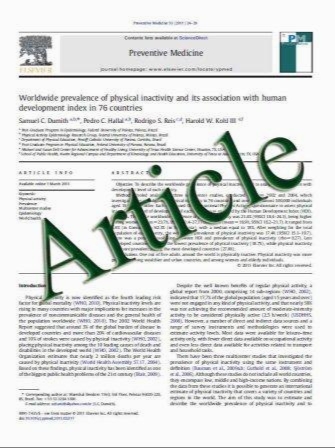Distinct mechanisms for diastolic dysfunction in diabetes mellitus and chronic pressure-overload
- نوع فایل : کتاب
- زبان : انگلیسی
- مؤلف : Ineˆs Falcaکo-Pires Giuseppina Palladini Na´dia Gonc¸alves Jolanda van der Velden Daniel Moreira-Gonc¸alves Daniela Miranda-Silva Francesc
- چاپ و سال / کشور: 2011
Description
Chronic pressure-overload and diabetes mellitus are two frequent disorders affecting the heart. We aimed to characterize myocardial structural and functional changes induced by both conditions. Pressure-overload was established in Wistar-han male rats by supra-renal aortic banding. Six-weeks later, diabetes was induced by streptozotocin (65 mg/kg,ip), resulting in four groups: SHAM, banding (BA), diabetic (DM) and diabetic-banding (DB). Six-weeks later, pressure–volume loops were obtained and left ventricular samples were collected to evaluate alterations in insulin signalling pathways, extracellular matrix as well as myofilament function and phosphorylation. Pressure- overload increased cardiomyocyte diameter (BA 22.0 ± 0.4 lm, SHAM 18.2 ± 0.3 lm) and myofilament maximal force (BA 25.7 ± 3.6 kN/m2, SHAM 18.6 ± 1.4 kN/m2), Ca2? sensitivity (BA 5.56 ± 0.02, SHAM 5.50 ± 0.02) as well as MyBP-C, Akt and Erk phosphorylation, while decreasing rate of force redevelopment (Ktr; BA 14.9 ± 1.1 s-1, SHAM 25.2 ± 1.5 s-1). At the extracellular matrix level, fibrosis (BA 10.8 ± 0.9%, SHAM 5.3 ± 0.6%), pro-MMP-2 and MMP-9 activities increased and, in vivo, relaxation was impaired (s; BA 14.0 ± 0.9 ms, SHAM 12.9 ± 0.4 ms). Diabetes increased cardiomyocyte diameter, fibrosis (DM 21.4 ± 0.4 lm, 13.9 ± 1.8%, DB 20.6 ± 0.4 lm, 13.8 ± 0.8%, respectively), myofilament Ca2?sensitivity (DM 5.57 ± 0.02, DB 5.57 ± 0.01), advanced glycation end-product deposition (DM 4.9 ± 0.6 score/mm2, DB 5.1 ± 0.4 score/mm2, SHAM 2.1 ± 0.3 score/mm2), and apoptosis, while decreasing Ktr (DM 13.5 ± 1.9 s-1, DB 15.2 ± 1.4 s-1), Akt phosphorylation and MMP-9/TIMP-1 and MMP-1/ TIMP-1 ratios. Diabetic hearts were stiffer (higher enddiastolic- pressure: DM 7.0 ± 1.2 mmHg, DB 6.7 ± 0.7 mmHg, SHAM 5.3 ± 0.4 mmHg, steeper end-diastolicpressure– volume relation: DM 0.59 ± 0.18, DB 0.83 ± 0.17, SHAM 0.41 ± 0.10), and hypo-contractile (decreased end-systolic-pressure-volume-relation). DB animals presented further pulmonary congestion (Lungs/ body-weight: DB 5.23 ± 0.21 g/kg, SHAM 3.80 ± 0.14 g/kg) as this group combined overload-induced relaxation abnormalities and diabetes-induced stiffness. Diabetes mellitus and pressure overload led to distinct diastolic dysfunction phenotypes: while diabetes promoted myocardial stiffening, pressure overload impaired relaxation. The association of these damages accelerates the progression of diastolic heart failure progression in diabeticbanded animals.
Basic Res Cardiol (2011) 106:801–814 Received: 23 August 2010 / Revised: 7 March 2011 / Accepted: 20 April 2011 / Published online: 1 May 2011


